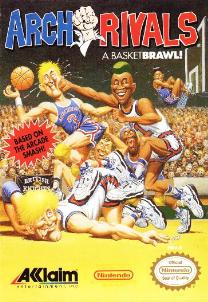Software:Arch Rivals
| Arch Rivals | |
|---|---|
 NES cover art | |
| Developer(s) | Midway Rare (NES) Arc Developments (Game Gear, Genesis) |
| Publisher(s) | Midway Acclaim Entertainment[lower-alpha 1] |
| Designer(s) | Jeff Nauman and Brian Colin |
| Programmer(s) | Jeff Nauman |
| Artist(s) | Brian Colin |
| Composer(s) | Dan Forden David Wise (NES) Mark Cooksey (Game Gear, Genesis) |
| Platform(s) | Arcade, NES, Mega Drive/Genesis, Game Gear |
| Release | 1989: Arcade 1990: NES 1992: Mega Drive, Game Gear May 19, 1992: Genesis[1] |
| Genre(s) | Sports (basketball) |
| Mode(s) | Single-player, multiplayer |
Arch Rivals is a basketball video game released by Midway for arcades in 1989. Billed by Midway as "A Basket Brawl", the game features two-on-two full court basketball games in which players are encouraged to punch opposing players and steal the ball from them. Arch Rivals was the second basketball video game released by Midway, sixteen years after TV Basketball (1974).[2] Home versions of the game were released for the Nintendo Entertainment System, Genesis/Mega Drive, and Game Gear.
Arch Rivals allows players to select from a variety of fictional teams (although arcade operators can change the team names to reflect real ones) and players. One playable character, "Tyrone" was also featured in the animated The Power Team segments of the television series Video Power.[3] In turn, the game has been considered a forerunner to Midway's popular arcade basketball game, NBA Jam.[4]
Emulated versions of the game are included in the compilations Midway Arcade Treasures 2, Midway Arcade Treasures Deluxe Edition, and Midway Arcade Origins.
Gameplay
Games generally follow standard basketball rules; a full game consists of four quarters, with four minutes each. Each team has two players, and the objective of the game is to outscore the opponent until the final buzzer sounds. A player can call for his teammate to pass him the ball or to shoot it in this battle royale.[5]
If the game results in a tie after four quarters, multiple sudden death overtime periods are added, in which case whoever scores the next basket will win the game. Every overtime period is one minute. If, however, no score occurs after overtime the procedure repeats.
The difference between Arch Rivals and other basketball titles is the ability to freely punch an opposing player without penalty and steal the ball away. The referee will only call shot clock violations. Also unique to the game are various on-court hazards such as soda cans and candy wrappers thrown onto the floor. If a ballhandler steps on those, he falls onto the floor allowing his opponent to steal the ball from him. Players could also fall over the referee in the same way as the objects on the floor, as well as steal the ball with a maneuver called the "flying leap" where the player would jump forwards at the opposition ball carrier. If the maneuver missed, the player would roll along the floor. If successful, the player would tackle the opposition holding the ball. In the Arcade version the "flying leap" would pull the opposition's shorts down, revealing the opponent's underwear.[5]
There are eight playable characters, each with a unique characteristic.[5] The teams in Arch Rivals are selected at random, with Player 1 playing as the home team and Player 2 (or the computer) as the away team. The teams in the arcade version are Chicago, Los Angeles, New York, Denver, Natural High and Brawl State.
Also, the arcade operator can customize the team names and colors through the game's "Hometown Heroes" feature.[6]
Ports
The four home ports of the game have lower-quality graphics than the arcade version, due to being released on 8 and 16-bit systems. The NES version of the game contains a glitch where a 3-point dunk can be achieved. The Sega Genesis version received poorer reception due to a glitch where almost 95% of shots taken from anywhere on the court would result in a basket.
It was also included on Midway Arcade Treasures 2 for the PlayStation 2, Xbox, and GameCube; Midway Arcade Treasures Deluxe Edition for Microsoft Windows; and Midway Arcade Origins for PlayStation 3 and Xbox 360.[7]
Reception
Sinclair User and Computer and Video Games published positive reviews of Arch Rivals, while commenting that the game was best suited to fans of the sport.[6][8]
See also
References
- ↑ "Press release: 1992-05-19: ACCLAIM BEGINS SHIPMENT OF SEGA SOFTWARE" (in en). 2016-06-10. https://segaretro.org/Press_release:_1992-05-19:_ACCLAIM_BEGINS_SHIPMENT_OF_SEGA_SOFTWARE.
- ↑ Ali, Reyan (22 October 2019). NBA Jam. Boss Fight Books. pp. 18–9, 34–5. ISBN 978-1-940535-20-3. https://books.google.com/books?id=9zC-DwAAQBAJ&pg=PA18.
- ↑ "NEW VIDEO SHOW BLENDS LIVE ACTION AND ANIMATED CAST". Sun Sentinel - Fort Lauderdale. June 17, 1990.
- ↑ Weiss, Brett Alan. "Arch Rivals - Review". All Game. http://www.allgame.com/game.php?id=9514&tab=review. Retrieved June 25, 2012.
- ↑ Jump up to: 5.0 5.1 5.2 "Arch Rivals". Killer List of Video Games. http://www.arcade-museum.com/game_detail.php?game_id=6905. Retrieved January 18, 2013.
- ↑ Jump up to: 6.0 6.1 "Arch Rivals - Bally/Midway". Sinclair User: 75. November 1989.
- ↑ "Midway Arcade Origins Review - IGN". 14 November 2012. http://www.ign.com/articles/2012/11/14/midway-arcade-origins-review.
- ↑ "Archrivals". Computer and Video Games: 111. October 1989.
- ↑ Released under the Flying Edge brand name on Sega systems.
External links
- Arch Rivals at Arcade-History
- Arch Rivals at MobyGames
 |


